Here is a very informative video called The Art Of Masonic Education, published on the Masons of CA YouTube channel:
Would you like tp leave a comment or question about anything on this post?

Here is a very informative video called The Art Of Masonic Education, published on the Masons of CA YouTube channel:
Would you like tp leave a comment or question about anything on this post?

The Square & Compass Productions YouTube channel just released this video on Edmonton Masonic Hall at 10318 100th Avenue in Edmonton, Alberta.
The Temple Lodge No. 33 Historian would like to start doing videos similar to this on Cowichan Valley buildings associated with Freemasons and Freemasonry.
Would you like to leave a comment or question about anything on this post.

We came across this 1960’s Masonic movie posted on YouTube:
Would you like to leave a question or comment about anything on this post?
We came across this interesting lecture from Hillsdale College by Dr. Richard Gunderman on the Importance Of The Liberal Arts, which have a prominent place in Masonic philosophy. Skip ahead to 1:25 for the start of the lecture.
Would you like to leave a comment or question about anything on this post?
Mike Gains, of Vancouver & Quadra Lodge No. 2 in Victoria, has provided us with some photographs he took during a recent visit to the McMillin Memorial Mausoleum in Roche Harbor, Washington.
Freemasons travelling to Roche Harbor may want to visit this site, which contains a lot of Masonic symbolism.
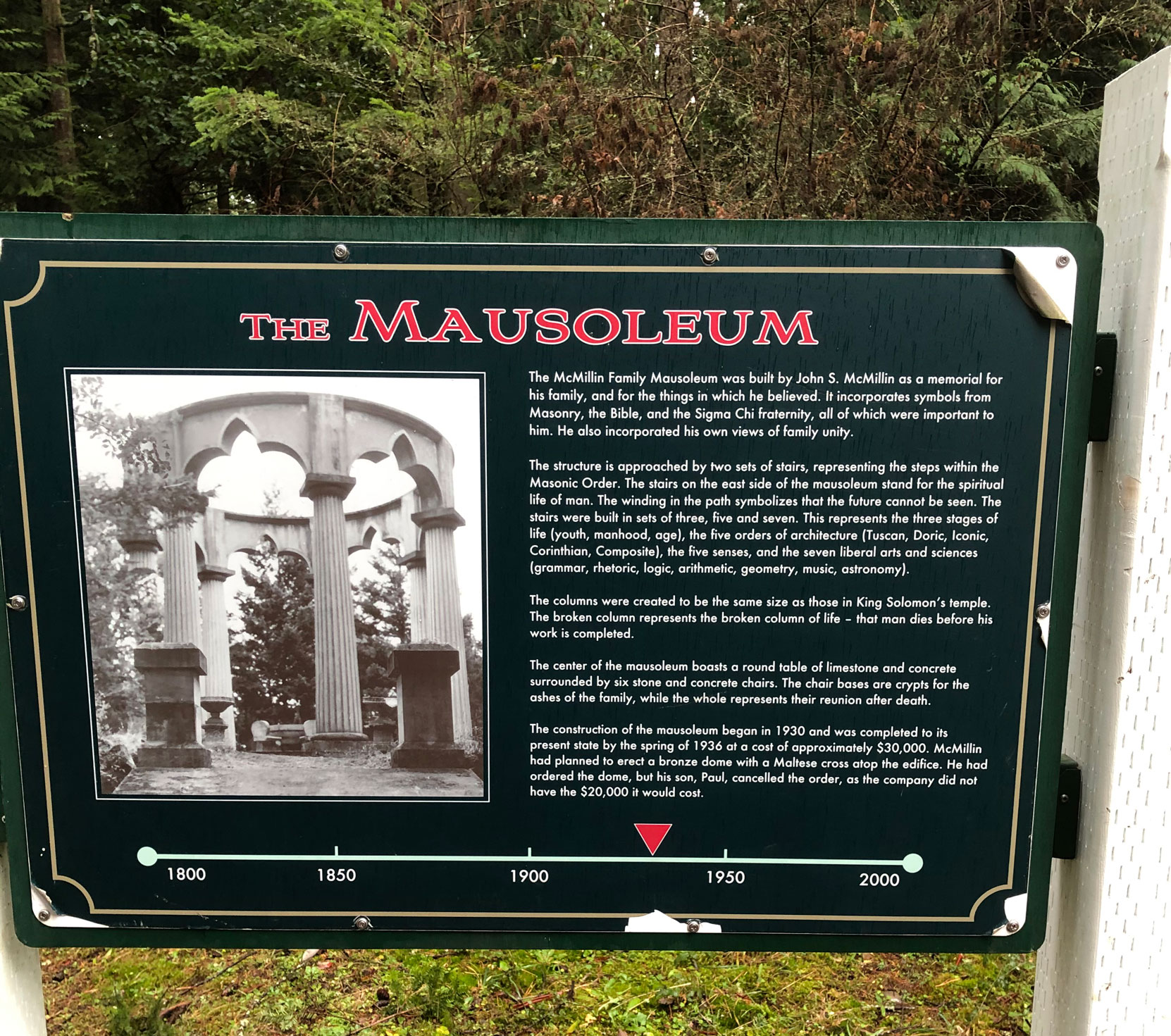
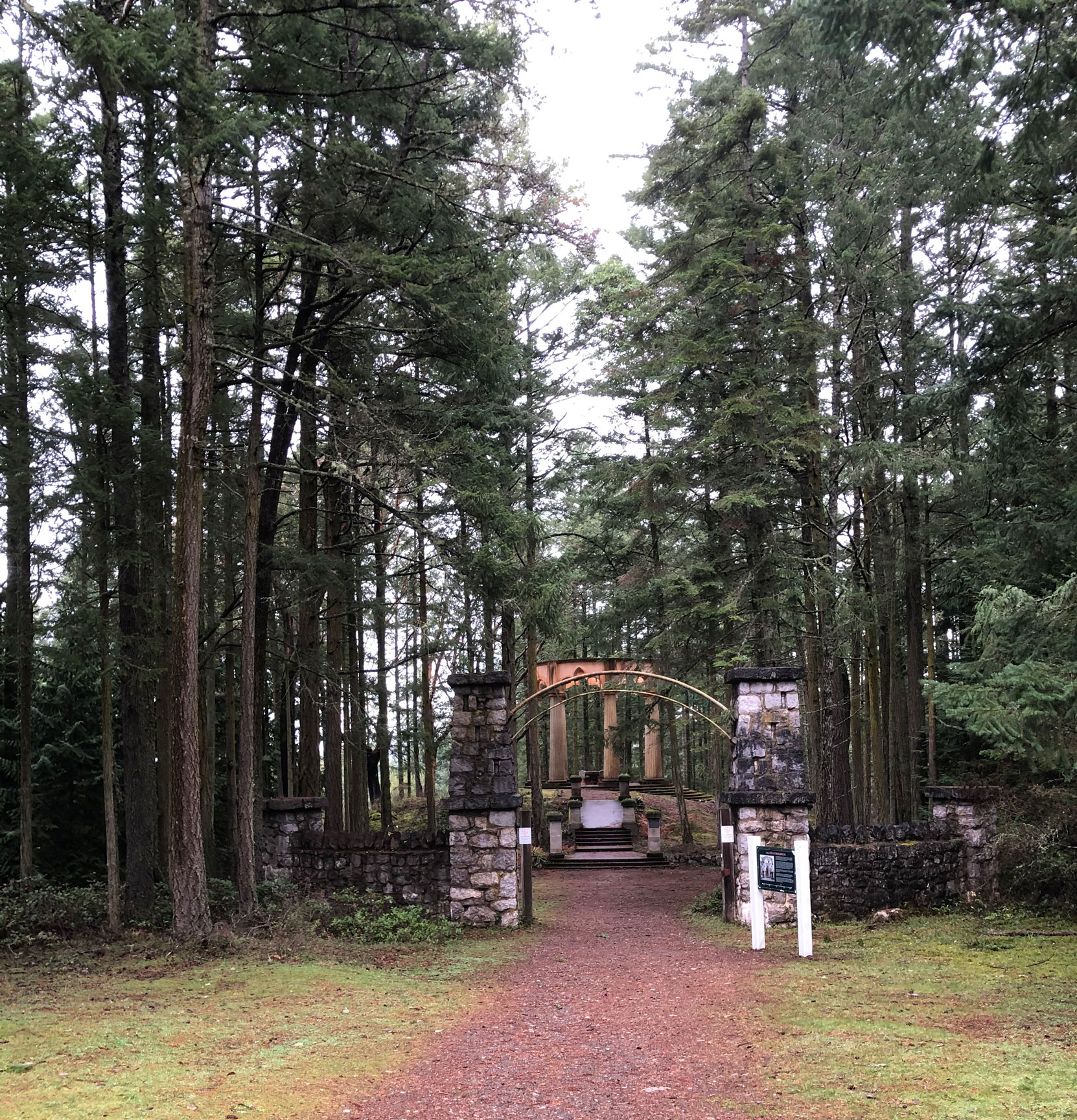
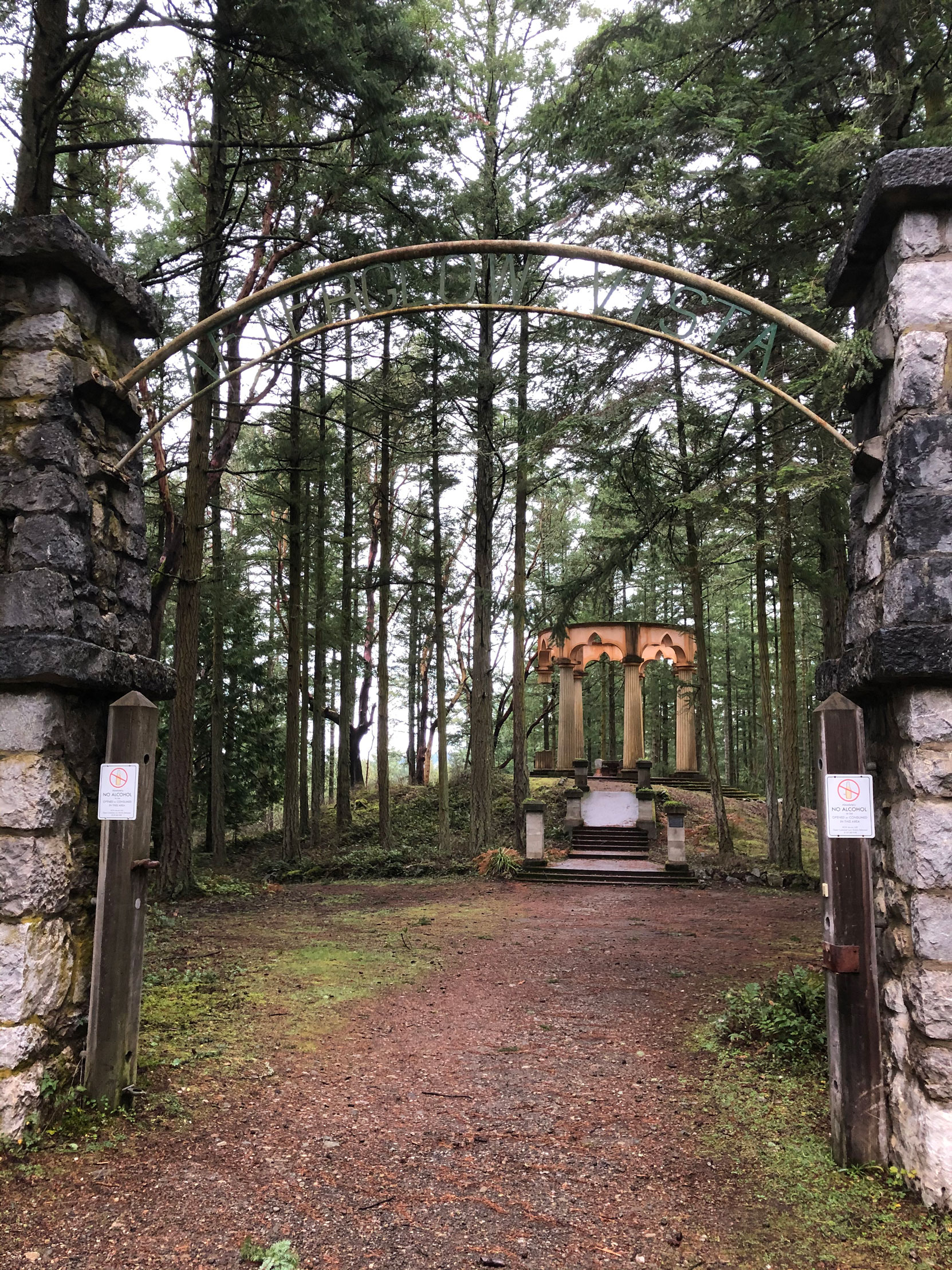
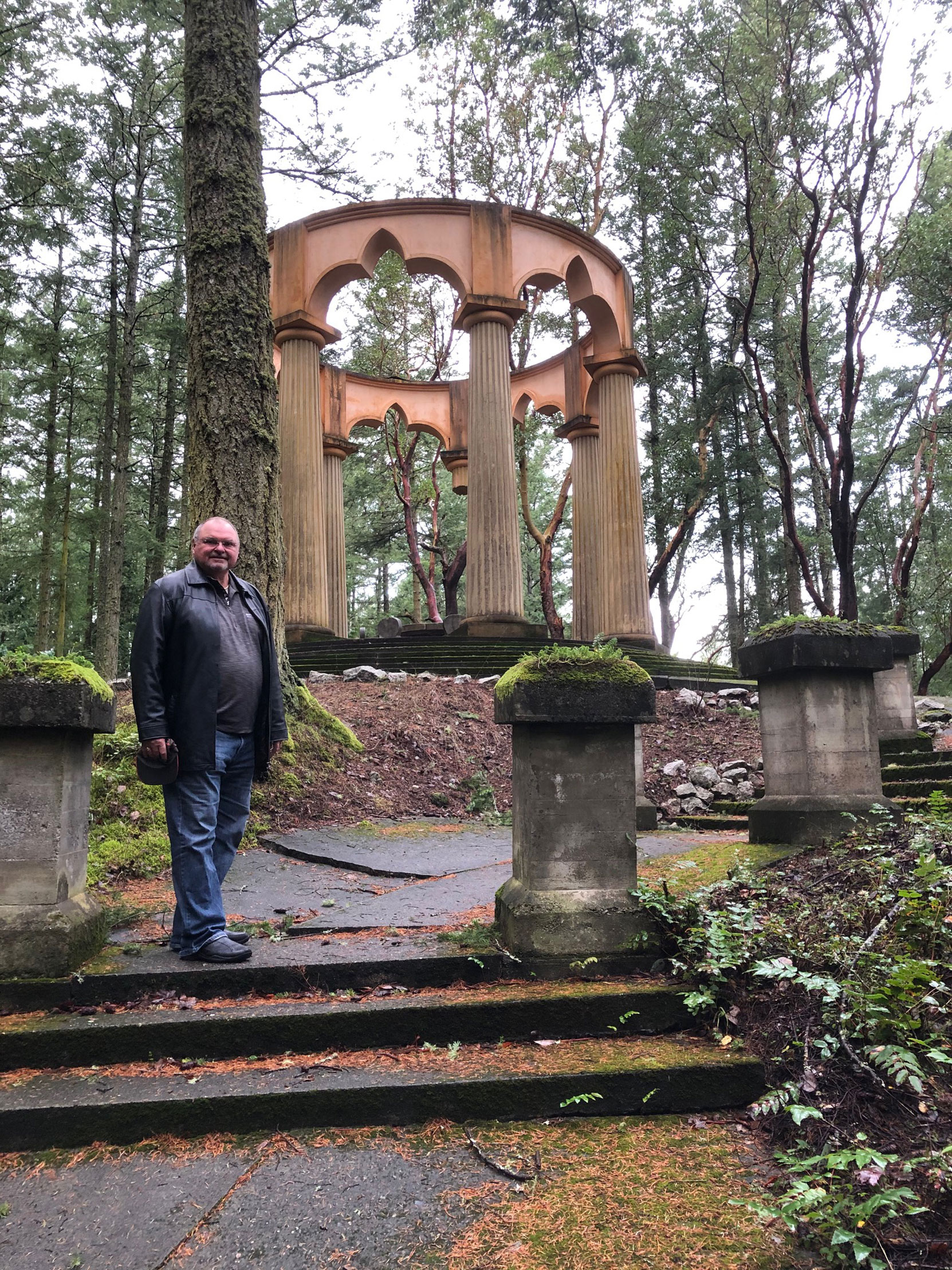
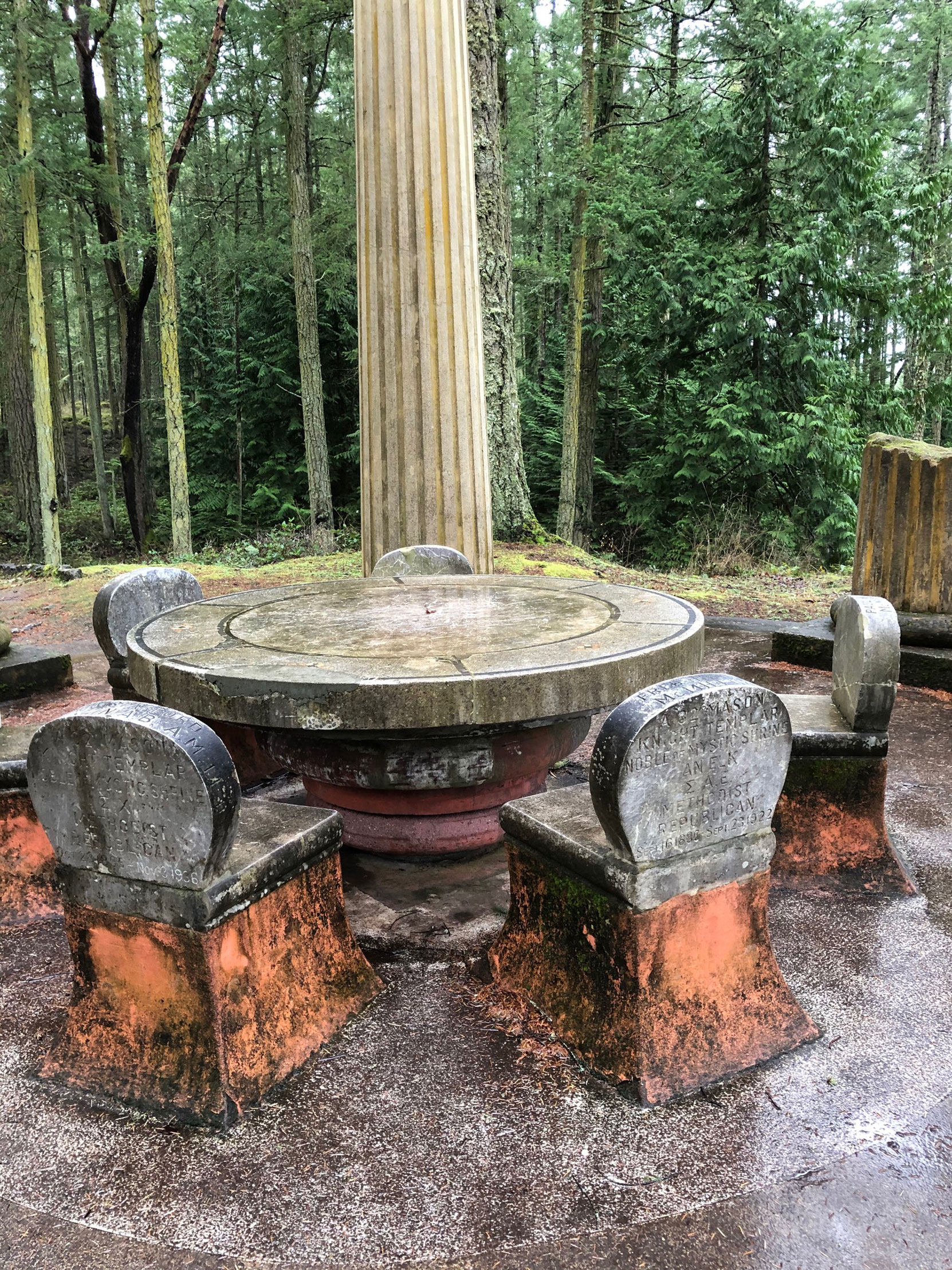
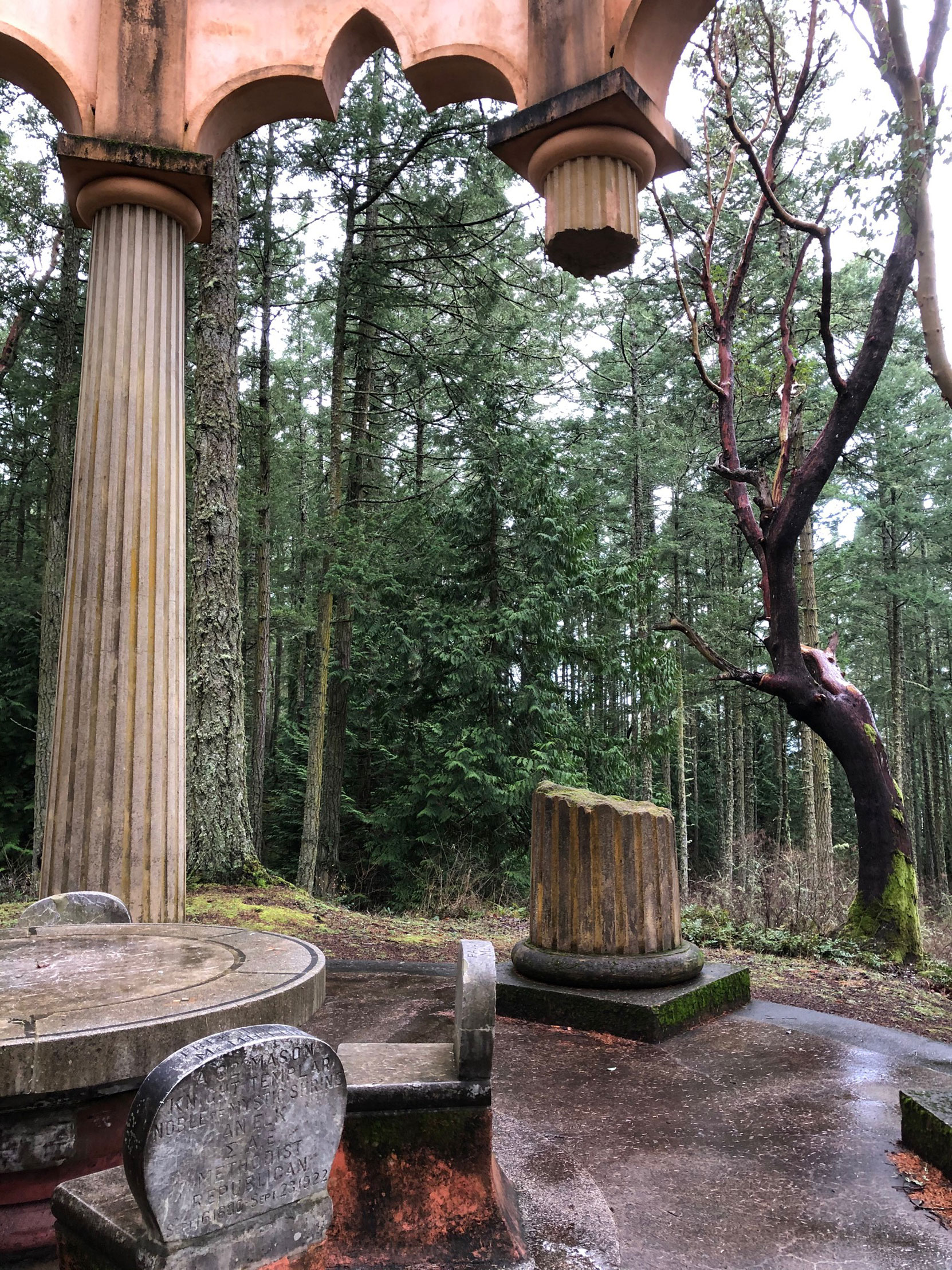
John S. McMillin was a lawyer who went into the lime business in 1886. Lime is a key component of cement, which was the key component of concrete. After 1876, concrete was becoming an increasingly popular building material and McMillin’s Roche Harbor Lime Company was a key supplier of cement in the western US.
John S. McMillin was a friend of Robert Pym Butchart, whose limestone quarries and cement factory at Tod Inlet is now the Butchart Gardens.
John S. McMillin and Robert Butchart were both Freemasons and Masonic symbolism is openly visible throughout the McMillin Mausoleum.
The entrance stairway consists of 3 steps, followed by 5 steps, followed by 7 steps. This is covered in the Fellow Craft Degree.
The Broken Column is a frequent feature of Masonic graves.
The circumference and diameter of the columns are the same as those of King Solomon’s Temple.
Here are some pages with more information on the McMullin Memorial Mausoleum:
Here is a map showing the location of McMillin Memorial Mausoleum in Roche Harbor, Washington:
For the philosophically inclined among our readers, here is an interesting 2011 video of Dr. David David Berlinski at the Hoover Institution discussing “Atheism and Its Scientific Pretensions” .
For those interested in reading more on this topic, here is a link to Dr. David Berlinski‘s book, The Devil’s Delusion: Atheism and Its Scientific Pretensions.
Here are some more videos featuring Dr. David Berlinski:
David Berlinski and Christopher Hitchens,
David Berlinski at the Hoover Institution, 2014
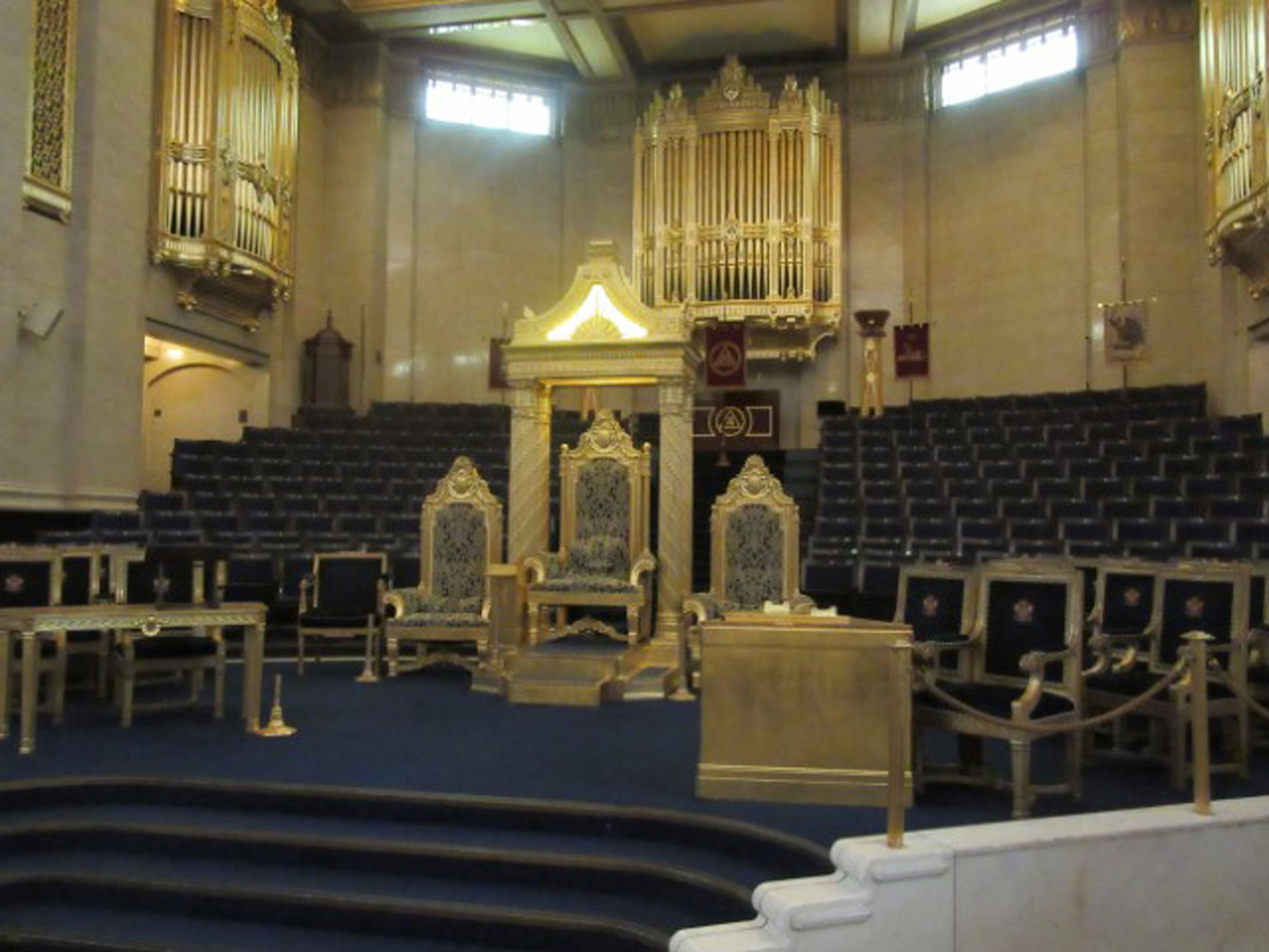
Would you like to leave a comment or question about anything on this post?
Temple Lodge No. 33 will be hosting the annual District 27 Masonic Education Day at the Duncan Masonic Temple on Saturday, 1 June 2019, 9:30 a.m. to 12 noon. There will be lunch afterwards.
The theme of the 2019 District 27 Masonic Education Day will be technology and its use in the Craft. The presenters will be as follows:
The District 27 Masonic Education Day is open to all Freemasons and their guests. There is no charge for this event.
It will be held at the Duncan Masonic Temple. We hope to see you there.
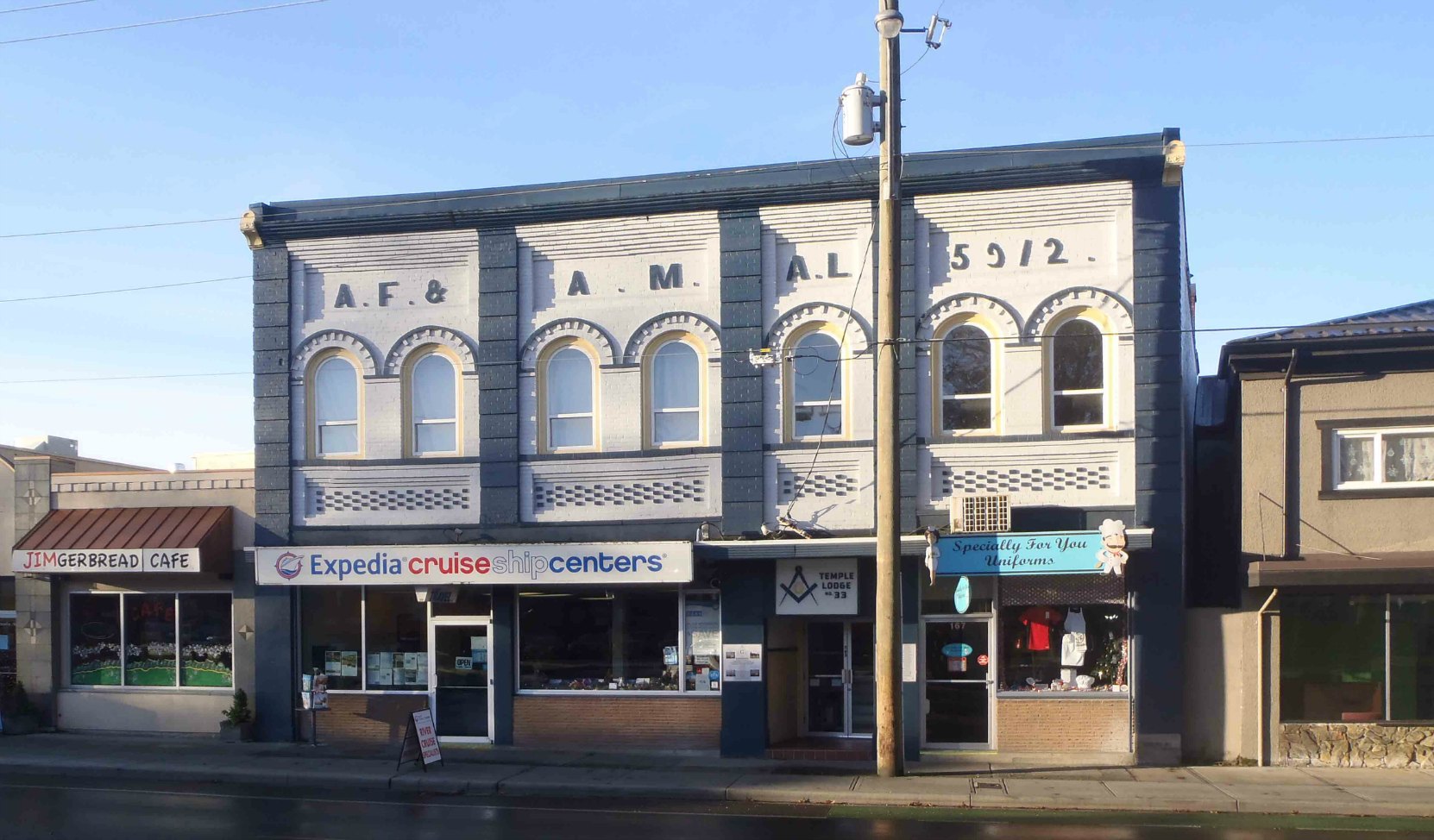
Congratulations to Brother Lawrence Lampson of Temple Lodge No. 33, who has received First Place in the annual Ashlar College of Freemasonry Writing Competition.
Here is Lawrence Lampson’s winning essay:
Musings to the ‘Mth’ degree….
“The True Nature of Freemasonry”
An Essay Written by Lawrence Lampson, Temple Lodge No. 33, Duncan B.C.
October 2018
This essay is an attempt to crystallize my thoughts into a cohesive form rather than to expound upon finished concepts. As I am quite new to Masonry, I would ask the reader to forgive any inconsistencies or inaccuracies in this attempt.
I understand masonry in its essence to be a path of self-development, a path steeped in ancient rites and forms that harkens back to antiquity. There are many facets to masonry, and many associated movements. I will attempt to address three aspects of the Masonic movement, and show their relationship to what I understand to be the true nature of Masonry.
First I will address the social aspect, then the form and ritualistic presentation, and thirdly the esoteric nature of the work.
To the Social Life of Masonry:
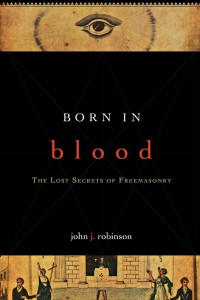
In his book “Born in Blood” The Lost Secrets of Freemasonry, John J. Robinson points out that all historical documents to the original purpose of masonry were lost or destroyed before the year 1717. Around this time Masons began meeting more openly. They held their meetings in pubs, and may have been seen to be using any deeper purpose as an excuse for a good night of cheer. Still today it is often talked about as an old boys club, with much emphasis on eating and drinking.
No doubt there is some truth to that, however I see the social aspects of masonry to be that of nurturing, and developing of a culture of chivalry, of practicing good social form, ethics and morality. It is a place where at least once a month I get dressed up and meet with like minded men and practice being a gentleman. If this alone were the level to which a man gave himself to masonry, it would already be making the world a better place through the practice of good form and moral behavior. The form and weight given to moral striving I think would eventually deter a person who was only looking for the camaraderie of pub culture.
Through the structure, oaths and commitments to each other, Masonry formed a safe-haven, which allowed men of all faiths and religions to come together safely, in times when doing so was punishable by horrific torture and death.
Through traveling and visiting other lodges (which is strongly encouraged), horizons are broadened. A new awareness for one’s fellow man is kindled, and prejudices overcome. There is a strong sense of community building and support here. I believe that one’s community is as large as ones circle of awareness is and ones willingness to take responsibility with in it. And so Masonry by its nature sets out to form a global community able to unite people of all faiths, a community of active and striving men with the intent to make the world a better place by setting a good example.
The form and ritualistic presentation:
The Masonic experience begins as we enter the lodge room, its walls hung with the symbols and regalia of the rituals and rites that date back to the middle ages. We commit the rites and rituals to our memories, and look with great care to the geometry of our movements within the lodge. There is a somber earnestness with which this work is carried out, which could almost be religious. And yet it is not. The form and imagery and the sincerity within the Lodge room lends a sense of importance, and I believe it serves as a support to motivate and shepherd us past the perils and pitfalls of this path of self-development.
The memory work, and the “pageantry” of the rituals, brings to mind for me, the 12th century Arthurian legends of the “Knights of the Round Table” and their striving to bring about new social awareness. The table at which Arthur and his knights ruled was purposefully round so that there was no head of the table, and all who sat around it met as equals. This New form of governance and ideology is inspiring and I feel it is still valid today. I see parallels in the Masonic lodge. In the Lodge we meet ‘on the level’, meet as equals disregarding our different positions in life, and share a rotating leadership which all strive to take part in.
The spiritual or esoteric nature of Masonry:
Masonry as an esoteric path is an individual path, which means I can only comment very generally about it. Each of us is free to make out of it what he can. But the structure of rituals, and degree work, makes it hard for an inquisitive mind to ignore the lessons. It occurs to me that each of these lessons is a lesson for life, which continues to show deeper meaning as we deepen our understanding.
Most paths of spiritual development are described as ‘a journey’ to be taken step-by-step. The mysteries of Freemasonry are revealed by degrees. The Masonic movement throughout its history has been shrouded in secrecy and mystery. Out of historical necessity of self-preservation the movement developed into a brotherhood, with a complex set of passwords signs and symbols, and its rules and structures are akin to an order of monks or knights. It is nonetheless a path of self-development to be embarked upon by individual men. And as such, to the extent the individual gives himself to this path of self-improvement, the mysteries of freemasonry will come to light. It is often said one gets out of Masonry what one puts in. Perhaps these medieval forms and structures within Masonry create a support system that carries or nudges one toward a deeper striving, towards inner work.
Throughout the ages masons where thinkers; Many of the great artists, mathematicians, philosophers, and scientists, were Masons and their contributions are greatly valued still today. Masonic thinkers in the 17th and, 18th century embraced Deism, accepting the existence of a creator on the basis of reason, but rejecting the belief in a supernatural deity who interacts with mankind. They looked out into nature and saw God in the wonders nature, in the laws of nature, the hidden mathematics, the geometry and the wonders of science. Their thinking was based on reason, having become disenchanted with organized religion. They strove to remain free thinkers, developing and protecting streams of thought free of the dogma and the whims of the ruling powers of the day. Such thinking was risky, and thinkers and philosophers formed working groups and met in secret. Many of the founding Fathers of America were such Masonic thinkers, and brought these ideals into the foundations of the American constitution.
I see the nature of the Masonic Path of self-development in Wolfgang Von Eschenbach’s Grail legend Percival, which tells of the young son of a knight whose mother clothed and raised him as a peasant boy to protect him from the perils of his true destiny. Percival however is drawn to his destiny and becomes a knight. After long searching, He finds himself in an enchanted castle, where his uncle is suffering greatly under an enchanted ailment. Percival in his innocence is unprepared, and does not know to ask the question, which would unlock the spell:
“Uncle what ails you?”
“Striking in this work is the emphasis on the importance of humility, compassion, sympathy and the quest for spirituality. A major theme in Percival is Love…”
The imagery of this fairy tale describes a spiritual quest. In the Masonic degree work the candidate is also presented half dressed half shod, a poor traveler journeying to the east to find light. At the heart of the Masonic path we also find the same underlying tenets as key aspects of the work: interest in ones’ fellow man, the development of humility, compassion and the quest for enlightenment. I see a parallel also in the heart of the Temple legend where three Fellow-craft Masons attempt to get the Masters word, prematurely. One could say they are attempting to enter the grail castle, unprepared.
Conclusion
In conclusion, I have chosen three aspects of Masonry, the social, the ritualistic forms and the esoteric, and have shown their relationship to the true Nature of Masonry as I see it. The social life of masonry naturally brings out the best in men through the practicing of good form and moral behavior. Through community building and through interest in ones’ fellow man, the Masonic fraternity becomes a safe haven in which to work and develop inner self. The form and ritualistic aspects bring us out of the daily routine, and adds significance to our fragmented lives, helping to guide or shepherd us along this path. The esoteric aspects of masonry, point us to our calling, and aid us in creating a better world by example.
Citations:
Robinson, John J., “Born in Blood” The Lost Secrets of Freemasonry, M Evans and Company Inc. 1989
Barber, Katherine, The Arthurian Legends: an Illustrated Anthology, W.S.Cowell Ltd. 1979
Goghlan, Ronan, Encyclopedia of Arthurian Legends, Elements Books Ltd. 1993
Goodrich, Norma Lorre., King Arthur., Franklin Watts, 1986
Paterson, Katherine, Parcival: The Quest of the Grail Knight. Penguin Books Ltd, 1998
Wikipedia,
“ Striking in this work is the emphasis on the importance of humility, compassion, sympathy and the quest for spirituality. A major theme in Perceval is Love…” https://en.wikipedia.org/wiki/Parzival
Wikipedia, Deism https://en.wikipedia.org/wiki/Deism

Would you like to leave a comment or question about anything on this post?
Today is Holocaust Remembrance Day and it is fitting that we remember all who died in the Holocaust, including the Freemasons who were specifically targeted by the Nazis.
In Nazi controlled areas, Freemasons were made to wear a Red Triangle on their clothing. Many of our Masonic Brethren died in Nazi concentration camps.
Here is a 1959 paper on Freemasons and the Holocaust, reproduced here with the permission of the Grand Lodge of Antient Free & Accepted Masons of Scotland. We will go through it and gradually add links to names for readers’ benefit.
HOLOCAUST MEMORIAL DAY – 27 JANUARY ANNUALLY
[It is fitting that on this day we reproduce an erudite, if lengthy, paper of the persecution of Freemasons by the Nazis before and during WWII
We do so to once again place evidence of the victimisation of Freemasons by the Nazis in the public domain in the fervent hope that it will not, once again, slip from the public consciousness – Ed.]
A STUDY IN NAZI PERSECUTION
W. Irvine Wiest
A Paper Read at the Fifteenth Annual Consistory of the Society of Blue Friars
Washington, D.C., 22nd February 1959.
Reproduced by kind permission of that Society
PART 1
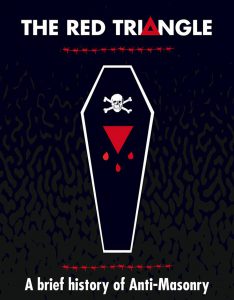
All Masons everywhere know of the persecution of their brethren in Europe and the spoliation of their property by the Nazi Party and the German Reich before and during World War II. But it may come as a surprise to many that the Nazi treatment of Freemasons and Freemasonry had a part to play in the trial and conviction of Hermann Goering, Alfred Rosenberg, Julius Streicher and the other infamous members of the Nazi hierarchy by the International Military Tribunal at Nuremberg. This, of course, does not mean that they were tried and convicted solely because of their persecution of Freemasonry. The indictment contained four counts, namely, (1) that the defendants had engaged in a common plan or conspiracy (2) to commit crimes against peace, (3) war crimes, and (4) crimes against humanity. The third count, that of committing war crimes, had ten subdivisions, in the fifth of which the plunder of public and private property was treated as being in the same category as the murder and ill treatment of civilian populations, the utilization of slave labor, the killing of hostages and the like. It was under this count that most of the evidence of the persecution of Masonic lodges was admitted in evidence.
In 1946 and 1947 the United States Government printing office published a set of books in a limited edition, which has now become a collector’s item. It is entitled Nazi Conspiracy and Aggression and was prepared by the Office of United States Chief of Counsel for Prosecution of Axis Criminality. It ran to eight volumes plus two supplements, and an additional volume containing the judgment and sentence of the tribunal. In addition to that and to the charter under which the tribunal was set up, it contains the indictment under which the defendants were tried, the arguments of the prosecuting and defence counsel, the statements made by the defendants on their own behalf and the prosecution’s trial brief. By far the largest portion of the trial brief consists of translations of captured documents found in the private and official files of many of the defendants and of the organizations they headed. All the material in this paper is to be found in these documents, or, in one instance, in the pre-trial examination of Alfred Rosenberg, and, in another, in a letter written by von Ribbentrop after his capture.
The Nazi persecution of Freemasons and Freemasonry has been ably reported by a Committee of the Masonic Service Association, which went to Europe in the summer of 1945, shortly after the collapse of Germany, for the purpose of investigating the “condition of Masonry in the devastated countries of Europe.” It was composed by Ray V. Denslow, editor of The Royal Arch Mason, Past Grand Master of Missouri, and at that time the General Grand High Priest of the General Grand Chapter of the United States, chairman; Hon. George E. Bushnell, now the Sovereign Grand Commander of the Ancient Accepted Scottish Rite, Northern Masonic Jurisdiction, but at that time Lieutenant-Commander of the Rite and Chairman of the Committee on Jurisprudence of the Grand Lodge of Michigan; Charles H. Johnson, Past Grand Master and Grand Secretary of the Grand Lodge of New York; and Claude J. McAllister, Past Grand Master of Montana and Fraternal Correspondent and Historian of the Grand Lodge of Montana.
In the report the committee made upon its return, it told of the persecution of individual Freemasons, the pillaging of lodges and the destruction of many of their temples. It is no part of the purpose of this paper to review that report, for it has been widely publicized among the craft. But I do want to use one quotation from the report in order to show that the documentary evidence used in the trials confirms the committee’s statement, and in order that the reader may more easily understand certain things which appear in the documents.
After a general review of the manner in which the persecution started, including Hitler’s views as expressed in Mein Kampf, the committee said: “Then [Hitler] began to associate Freemasonry with the Jews in such a way that the reader might take it for granted that all Freemasons were Jews and all Jews were Freemasons.” In reviewing the documents, which probably were unknown to the committee at the time of their report, we shall see the words “Jews” and “Freemasons” in juxtaposition in nearly every instance.
The Nazis were obsessed with the idea that Freemasons were their enemies, so much so that they used many arms of the party and state to bring discredit to the Craft, death to many of its members and irreparable loss to many, if not most, of its lodges. The Gestapo [Secret Police], the SA [Storm Troopers], the SS [Blackshirts], the members of the armed forces, and even the foreign office were used.
Mr Justice Robert Jackson, chief of the United States’ prosecution staff, said in his argument before the court: “In connection with the persecution of the Jews, the SA again performed its propaganda function. It was the function of the SA to create and foster among the people an anti-Jewish spirit. Evidence of this function is to be found in the issues of Der SA-Mann. Article after article in this publication was devoted to propaganda designed to engender hatred toward the Jewish race. The nature of these articles is apparent from some of the titles (including an) article entitled `Jews and Freemasons,’ 13 January 1939, p. 15.”
Again, later in his argument, Mr Justice Jackson told the court: “The headquarters organizations of Gestapo was set up on a functional basis. In 1943 it contained five subsections, one of which (Section B) dealt with political churches, sects and Jews and was subdivided as follows:
Mr Justice Jackson could have told the court of other articles in Der SA-Mann, such as “The World Polyp of Freemasonry: A Dangerous Enemy Must Be Made Powerless,” 23 February 1935, page 2; “Revolts and Disturbances — The Work of the Freemasons,” 28 March 1936, page 11; “5 Million Freemasons — A World Threat,” 5 March 1938, page 6.The Organization Book of the NSDAP [Nazi Party] at page 413 was found to contain the following: “Bravery is valued by the SS men as the highest virtue of men in a struggle for his ideology. He openly and unrelentingly fights the most dangerous enemies of the state: Jews, Freemasons, Jesuits and political clergymen.”The armed forces were subjected to the propaganda that Freemasonry had to be counted as one of their enemies. One document entitled “The Bearer of Arms — Political Soldier,” dated June 6, 1939, contained a draft of a speech for the opening of a training course for commanders in Munich. The draft, or outline, is partially as follows:
“The next war will be the struggle for the victory of our ideology.
“Democracies led by Jews and Freemasons against Totalitarian States.
“At the end of such a war there must be a clear decision — no compromise solution.
“It is therefore a matter of existence or non-existence.”
In January 1939, a letter was addressed to the Ministry for Foreign Affairs to all senior Reich authorities and the NSDAP Bureau for Foreign Affairs as follows: “Enclosed please find for your attention a circular which has been sent to the German authorities abroad on the subject of `The Jewish Question as a factor in German foreign policy for the year 1939.'”
The circular read partly as follows: “In North America, in South America, in France, in Holland, Scandinavia, Greece, everywhere, wherever the flood of Jewish immigration reaches, there is today already a visible increase in anti-Semitism. A task of the German foreign policy must be to further this wave of anti-Semitism. Salonika reported on 30 November 1938 `That forces are at work to stir up hate against the Jews’ and that at the same time Greek Freemasonry is endeavouring to stem the anti-Semitic movement.”
Another foreign office document is a secret letter mailed 8 April 1944, to all the representatives of the office in Europe. It dealt with the establishment of an organization whose purpose was to deepen and strengthen anti-Jewish information in foreign countries. Included are the minutes of a work conference by the consultants on Jewish questions of the Jewish missions in Europe, held at Krummhuebel, 3 and 4 April 1944. The letter contains the following paragraph: “Prof. Mahr suggests that duplicates of handbooks and reference books be obtained and sent to Krummhuebel for the projected archives. He recommends, further, the addition of lists of Freemasons of high degree, journalists, writers and businessmen who had Jewish relatives.
Among the documents used by the prosecution was an article in the Voelkischer Beobachter for 28 August 1939, reporting a speech by Rudolph Hess. The heading and part of the article are as follows:
“RUDOLPH HESS ANSWERS CHAMBERLAIN.
We stand by the Fuehrer’s banner, come what will.
The Fuehrer’s deputy again gives proof of England’s responsibility.
Graz, August 25th.
“The 7th Reich session of `Germans Abroad,’ as already reported in another section of this issue, was opened in Graz on Friday evening with a great demonstration on the Trabrennplatz (racecourse). A culminating point in the proceedings which took place with strong support from the population of Graz was a speech by the Fuehrer’s deputy, Reich Minister Rudolph Hess.
(Among other things he said):
“Jews and Freemasons want a war against this hated Germany, against the Germany in which they have lost their power.”
A secret report issued in June 1939 by the Reichsfuehrer of the Chief of the Reichs Security Main Office dealt with the seizure of the leading men of the System Era. According to the report, a total of 553 men were seized. An analysis made by the author of the report showed that of that number, 58 or 10 per cent were Jews and 45 or 9 per cent were Freemasons.
It is therefore clear that Jews and Freemasons were almost always treated in the same manner by the Nazis. They scarcely ever mention one without naming the other in the same breath. No wonder their persecution of the Craft led to such dreadful results for Freemasons, for the whole world knows how they treated the Jews.
Arthur Seyss-Inquart, on 14 July 1939, wrote a letter addressed to the General Field Marshal from Vienna. He said: “If I may add something about myself, it is the following: I know that I am not of an active fighting nature, unless final decisions are at stake. At this time of pronounced activism this will certainly be regarded as a fault in my personality. Yet, I know that I cling with unconquerable tenacity to the goal in which I believe. That is Greater Germany and the Fuehrer. And if some people are already tired out from the struggle and some have been killed in the fight, I am still around somewhere and ready to go into action. I told myself in July 1934 that we must fight the clerical regime on its own ground in order to give the Fuehrer a chance to use whatever method he desires. I told myself that Austria was worth a mass. I have stuck to this attitude with an iron determination because I and my friends had to fight against the whole political church, Freemasonry, Jewry, in short, against everything in Austria. The slightest weakness which we might have displayed would undoubtedly have led to our political annihilation; it would have deprived the Fuehrer of the means and tools to carry out his ingenious political solution for Austria.”
This is the same man in whose personal files were found a memorandum of a meeting held 28 December 1918, which seems to show that he was not above imitating the secrecy and degree system of Freemasonry at the same time he was fighting the craft. The memorandum is as follows:
“Place: Vienna I. Am Hof 5
“Present: The Organizers
“After full discussion of the available drafts those present agreed to immediately take in hand the constitution of the planned organization.
“The name chosen is `Deutsche Gemeinschaft’ (German Association).
“The present are in agreement regarding the following principles of the organization.
Only one of the defendants, Joachim von Ribbentrop, ever appeared to make any denial of personal responsibility for, and to assert his opposition to, the Nazi persecution of Freemasonry, and that was after he was captured; and he placed his opposition to the persecution on the ground that it made his work harder as Foreign Minister of the German Reich. In a letter addressed to Prime Minister Churchill and Foreign Secretary Anthony Eden, which he enclosed in a letter to Field Marshal Montgomery with the request that it be forwarded to him, he wrote: “The German foreign policy was in every phase directed by the Fuehrer himself. Its execution was my task. After my appointment as head of the German Foreign Office I have considered it my business to help the Fuehrer in attaining the justified German claims in Europe — as laid down by Hitler — and this by diplomatic means. But at the same time I have considered it just as important to help to adjust the dynamics in the National Socialist doctrine and its principles of world conception (Weltauffassung) with the necessities and possibilities of foreign politics. My work was accordingly concentrated on the following, or better, on the double aim:
“(a) Concentration of the greater part of the Germans in Europe within the Reich and limitation of the German foreign policy, to the fulfilment of this aim; and
“(b) Evolution of the principles of world perception (Weltauffassung) of the party in such a way that the existence or carrying through of such principles would not endanger or even make impossible the peaceful living together and collaboration of Germany with other nations. This had to do especially with the question of toleration or better adjustment in matters of the churches, in the Jewish question, the question of communism, Freemasonry, etc., for which I have always pleaded in my verbal reports, memorandums, etc. ….
“I have been a patriot all my life. I have placed myself at the disposal of Adolph Hitler in the desire to help him save our country from ruin in 1933 and to build up a strong and united Germany in Europe and simultaneously to attain the English-German alliance without war…. I always was an opponent to the radical party programme. I have always opposed the policy against the Jews, churches, Freemasons, etc., which I considered in principle a fault and which has caused considerable difficulties in foreign politics.”
PART 2
The looting of Masonic lodges and the confiscation of their libraries and archives was the special task of the defendant Alfred Rosenberg.
Early in 1940, Hitler made plans for the creation of a research centre for the Nazi party and the German Reich which was to become a place where the Nazis could study the writings and methods of their enemies, in order that they might better combat them in the future. It was to be called the Hohe Schule. On January 29 of that year he issued a decree in the following terms: “The Hohe Schule is supposed to become the centre for National Socialistic ideological and educational research. It will be established after the conclusion of the War. I order that the already initiated preparations be continued by Reichsleiter Alfred Rosenberg, especially in the way of research and the setting up of the library. All sections of party and state are requested to cooperate with him in this task.”
The prosecution’s trial brief states that what began as a project for the establishment of a research library developed into a project for the seizure of cultural treasures.
The order of 29 January 1940, was implemented by further orders, issued by the Chief of the Supreme Command of the Armed Forces. On 17 September 1940, the Chief of the Army High Command for the Military Administration in Occupied France received an order notifying him that Hitler had authorized Rosenberg to search lodges, libraries and archives in the west for material valuable to Germany, and to safeguard them through the Gestapo. He also had the authority to transport such material as might appear valuable to him to Germany and to safeguard them there. Less than a month later, similar notification was directed to be given the Military Administration in Belgium, and by 30 October 1940, Rosenberg’s activities were extended to the Netherlands, and later to Norway and Denmark.
To carry out his duties, Rosenberg set up a special purpose staff known as the Einsatzstab Rosenberg, and sent his representatives into the occupied countries to search lodges, libraries, and archives for material to be transported to Germany for use in the Hohe Schule. In this he had plenty of help. Goering got into the act on 1 May 1941, when he issued an order in which, after declaring that “the battle against Jews, Freemasons and other affiliated forces or opposite `Weltanschauung’ is a foremost task of National Socialism during the war,” continued as follows: “I therefore welcome the decision of the Reichsleiter Rosenberg to form staffs in all occupied territories for the purpose of safeguarding all research material and cultural goods of the above-mentioned groups, and transporting them to Germany. All party, state, and Wehrmacht Services are therefore requested to give all possible support and assistance to the Chief of Staff of Reichsleiter Rosenberg’s staffs, Reichshauptstellenleiter Party Comrade Utikal, and his deputy DRK-Feldfuehrer Party Comrade vom Beer, in the discharge of their duties. The above-mentioned persons are requested to report to us on their work, particularly on any difficulties that might arise.”
On 1 March 1942, Hitler issued from his Fuehrer’s Headquarters a decree which was directed to all Bureaus of the Armed Forces, the party and the state, which was as follows: “Jews, Freemasons and the ideological enemies of National Socialism who are allied with them are the originators of the present war against the Reich. Spiritual struggle according to plan against these powers is a measure necessitated by war. I have therefore ordered Reichsleiter Alfred Rosenberg to accomplish this task in cooperation with the Chief of the High Command of the Armed Forces. To accomplish this task, his Einsatzstab for the right (sic) occupation territories has the right to explore libraries, archives, lodges and other ideological and cultural establishments of all kinds for suitable material, and to contribute such material for the ideological tasks of the NSDAP and for scientific research work by the university (Hohe Schule).”
This decree was implemented on 5 July 1942, by a notice issued from the Reich Chancellory, where Hitler then had his headquarters, addressed to “The Highest Authorities of the Reich and to all departments directly subordinate to the Fuehrer,” in the following language: “The Fuehrer has charged Reichsleader Rosenberg in his capacity as delegate of the Fuehrer with the supervision of the entire spiritual and political education and schooling of the NSDAP, with the spiritual fight against the Jews and Freemasons as well as against all allied with them in their doctrinal opposition to National Socialism, as the instigators of the present war. For this purpose the Fuehrer has ordered that the staff of the Reichsleader Rosenberg shall have the right, in occupied territories under military government and in occupied Eastern territories under civil administration (this does not include the General Government) to search libraries, archives, lodges and all other political and cultural institutions of all kinds for suitable material for the fulfilment of his task, and to ask the competent army and police officers to confiscate the material thus procured for the world doctrinal tasks of the NSDAP, and for later scientific research work of the university, whereby the police political files will remain with the police, all other documents, however, to be turned over to the staff of Reichsleader Rosenberg….” A copy of the decree of 1 March 1942 was attached to the notice.
So much importance was attached to the material the Einsatzstab Rosenberg was collecting that on 10 August 1942, the Chief of the High Command of the Armed Forces issued an order to the effect that it was to be treated like armed forces goods. Apparently they were given priority in transportation, and were as well guarded as war material.
It will thus be seen that the assistance of every party, state and armed forces organization in Germany was enlisted in the task of confiscating Masonic property. How well they carried out this task is well known from the reports of destruction or desecration of Masonic Temples throughout Western Europe. Two official reports are included in the documents discovered and used by the prosecution staff. One of them, undated, tells of the activities of the Einsatzstab in the Netherlands and the results it achieved, in the following language:
“The Working group Netherland of the Einsatzstab Reichsleiter Rosenberg began its work in agreement with the competent representative of the Reichskommisar during the first days of September 1940. The execution of the past (sic), conforming with the Fuehrer’s orders, coordinated itself with the liquidation, that is, confiscation, according to civil law, of the various subversive institutions…. The screening of the material of the various Masonic lodges was taken care of primarily, and the library and the archives of the following lodges were sifted and all useful material was packed.
“Groot Oosten der Nederlands”
[There follow the names and locations of thirty-one Lodges in the Netherlands.]
Included in the report are also the names of ten lodges of the Droit Humain, a pseudo-Masonic body, in Amsterdam and The Hague, 35 lodges of the Independent Order of Odd Fellows, and 15 Rotary Clubs. To continue with the document:
“All together 470 cases combining material from the here mentioned lodges and from organizations of a similar status were packed and transported to Germany. Furthermore, everything the temple of the lodge in Nijmegen and the temple of the I.O.O.F. in Haarlem contained, was sent to Germany. Also, steel shelves for about 30,000 books were taken from the building belonging to the Grooten Oosten in Den Haag where they have so far been for the Bibliotheka Klossiana, containing parts of one library of the Grooten Oosten and the library of the Vrijmetseler Stichting. Amsterdam, are of great value. And so are the archives of the Grooten Oosten in Den Haag, containing all the historical documents of the lodges affiliated with the Grooten Oosten.
“To estimate the value of the Bibliotheke Klossiana, containing many rare pieces, it is to be remembered that in 1930 the Grooten Oosten der Nederlands, was offered $5,000,000 for the Bibliotheka Klossiana by Freemasons in the United States.
“A particularly valuable discovery was made by the working group searching the altars in the building of the Grooten Oosten in Den Haag. The Master Hammer of the Grooten Oosten, made of pure gold, with which some of its members had presented to the Grooten Oosten on its 60th anniversary, fell into our hands. It is a piece of high quality whose money value alone is estimated to be 3,000 Reichsmark….
“It is safe to say that the racks of books confiscated, packed and so far sent to Germany by the Working Group are of extraordinary scientific value and shall contribute an integral part of the library of the `Hohe Schule.’ The money value of these libraries, as shown in the case of the Klossiana, can only be estimated, but surely amount to 30 – 40,000,000 Reichsmarks….
“The temple and the museum of the Grooten Oosten der Nederlande. At present, both are needed for exhibitions on behalf of the Dienststelle of the Reichskommisar. With the end of the exhibition, temple furnishings and museum shall be turned over to us…. It is safe to say that the library of the Hohe Schule itself, with very little effort, receive an extraordinary amount of treasures which shall give it a unique position in the realm of questions regarding Judaism and Freemasonism.”
The other report is dated at Paris 8 August 1944. It is a progress report, with no details given. It is as follows: “The fight against Jews, Freemasons and the forces allied to them or otherwise ideologically opposed to us, has always been a most urgent task of National Socialism, especially during the war which has been forced upon us. In order to secure, within the areas occupied by Germany, all research material and the cultural effects of the groups indicated, and to dispatch them to Germany, the Fuehrer at the suggestion of Reichsleiter Rosenberg has ordered that libraries, archives, lodges and other ideological and cultural institutions of all kinds be searched for appropriate material, and that this be secured for the ideological instruction of the National Socialist Party.”
What were Rosenberg’s special qualifications for the persecution of Freemasonry? They appear in the documents assembled by the prosecution. He was the man who in 1930 wrote “The idea of honour — national honour — will be for us the beginning and end of all our thoughts and deeds. It does not permit besides itself any other equivalent centre of power, be it of whatever kind, neither Christian love, nor the humanity of the Freemasons, nor the Roman philosophy.”
Rosenberg was high in the Nazi party. He was one of 16 Reichsleiters who composed the party directorate. He was Hitler’s delegate for the supervision of the ideological education of the NSDAP movement. The German Leader Lexicon (Das Deutsche Fuehrerlexicon) for 1934-1935, listed, among his other accomplishments, the authorship of 16 publications, of which it stressed his book, The World Policy of Freemasonry. He had therefore set himself up as an authority on Masonry. But listen to his testimony during a pre-trial examination taken 25 September 1945, at Nuremberg:
“Q. Do you recall any further correspondence with Bormann regarding the acquisition of materials from libraries and archives?
“A. It is possible that I did correspond with the man, but I don’t remember it.
“Q. As a matter of fact, with reference to the statement that you have just made regarding private property, you wrote to Bormann on 1 July 1940 along that line, did you not?
“A. I can’t remember that.
“Q. Didn’t you set forth some theory, by which it could be justified, in the case of the French Masonic lodges?
“A. We had assumed that those great Masonic lodges in Paris had carried on an anti-German policy for years. I, as a matter of course, wanted to find out from the libraries whether I could find confirmation or otherwise of the opinion which we had been holding on that subject.”
In other words, here is the expert on Freemasonry, who wrote a book on its world policy, admitting he knew nothing about it, and that his activities in plundering lodge libraries and archives was for the purpose of learning whether perchance the charges he had hurled at the institution might possibly be correct. To continue with his testimony:
“Q. You advocated a confiscation of three libraries, didn’t you?
“A. Yes; a confiscation of such libraries.
“Q. What was the principle on which you believed it justifiable to confiscate those libraries?
“A. I didn’t consider that as an ordinary private French property, but as the property of an organization into the activity of which I wanted to go.
“Q. What was the basis on which you made this differentiation between property of this organization and any other private property?
“A. I told myself that actually it was a fighting organization, directed for some time against the German Reich.
“Q. In other words, you convinced yourself that it was all right, is that it?
“A. It so happened that same material was of interest to the police, and had been confiscated by the police. I only got hold of such material as was necessary for my research, to get the precise nature of their activities.
“Q. The fact of the matter is, is it not, that at least some of the materials in these Masonic lodges’ libraries was confiscated for your purposes?
“A. Yes….
“Q. In fact, were the available books and the historical archives of the Paris Masonic lodges given to the Hohe Schule?
“A. They arrived at Frankfurt and we set them up separately with other libraries. On account of the air raids, those libraries had been transferred to Schloss-Hungen…. It is possible that on account of the transportation, those libraries are no longer in the state in which I had them set up….
“Q. What was the mission you had received from the Fuehrer?
“A. I received the mission to confiscate Jewish and other libraries, which were to be considered as hostile and for a purpose of scientific research. In conjunction therewith I also received the mission to safeguard the works of art, which had been left in the houses and castles.
“Q. Did you establish an organization to carry out this mission?
“A. There was in Paris a representation of this Einsatzstab. They visited the various organizations and the various castles where those works of art existed. There a brief outline of them was made. They were packed up and forwarded to Germany. All things concerned with the Freemasons and Jews were forwarded to Frankfort-am-Main….
“Q. What did you have at the Hohe Schule?
“A. At the Hohe Schule I had all the works concerning the question of Jews and Freemasons. The other books not dealing with either the Jews or Freemasonry, but also of scientific value, were transferred to the library of the Hohe Schule at Tanzenberg near Klagenfurth.”
In view of such evidence it is no wonder that the International Military Tribunal, in its opinion and judgment, has the following to say with regard to Rosenberg and his Einsatzstab: “The defendant Rosenberg was designated by Hitler, on the 29th January 1940, head of the Centre for National Socialist Ideological and Educational Research, and thereafter the organization known as the `Einsatzstab Rosenberg’ conducted its operations on a very great scale. Originally designed for the establishment of a research library, it developed into a project for the seizure of cultural treasures. On the 1st March 1942, Hitler issued a further decree, authorizing Rosenberg to search libraries, lodges and cultural establishments, to seize material from these establishments, as well as cultural treasures, owned by Jews…. In many of the occupied countries, private collections were robbed, libraries were plundered, and private houses were pillaged.”
Mr Justice Jackson, in his opening address for the United States, said: “We will not ask you to convict these men on the testimony of their foes. There is no count of the indictment that cannot be proved by books and records. The Germans were always meticulous record keepers, and these defendants had their share of the Teutonic passion for thoroughness in putting things on paper.”
The reader may judge for himself whether Mr Justice Jackson kept his promise. The documents shriek the defendant’s guilt.
The author of the outline of the speech for the opening of the Munich training course for commandoes was absolutely correct when he said “it is therefore a matter of existence or non-existence,” although it is most likely he never dreamed for one minute that once the smoke of battle had cleared away it would be the persecutors of Freemasonry who would be non-existent. Freemasonry exists, and will continue to exist, so long as there are men of good will who believe in the Fatherhood of God and the Brotherhood of men.
Reproduced here with the permission of the Grand Lodge of Antient Free & Accepted Masons of Scotland.
Although the Four Cardinal Virtues – Prudence, Temperance, Fortitude and Justice – figure prominently in the Entered Apprentice Lecture, the lecture itself does not go into any detail about their significance or give much explanation of their importance. This post is intended to provide some additional information about the Four Cardinal Virtues. [note: this post is based on a presentation at our January 2018 Regular Meeting by our District Education Officer]
The Four Cardinal Virtues are deeply rooted in Western philosophy. A stained glass representation appears below.
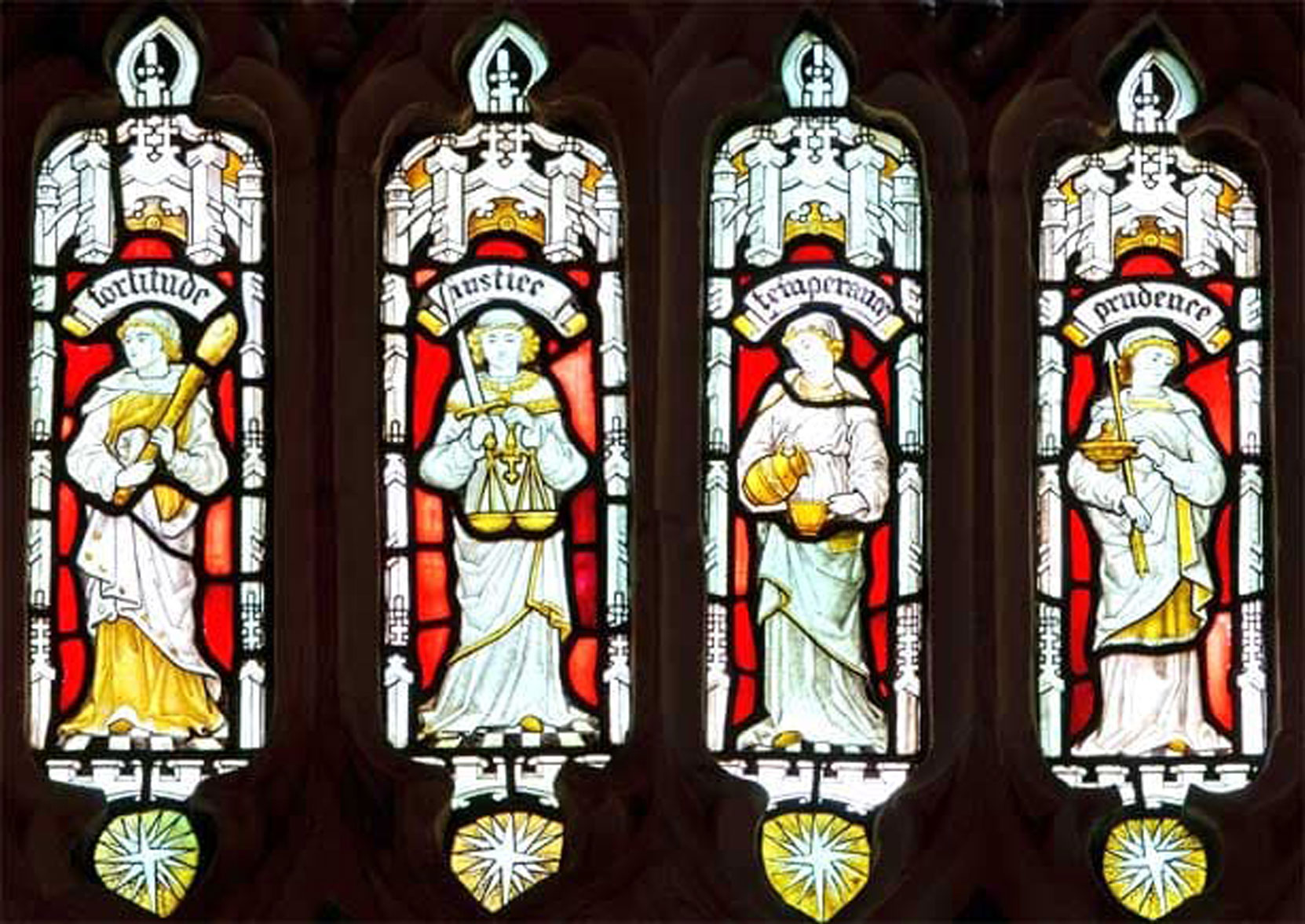
The figures below show the Four Cardinal Virtues as they are presented on stained glass windows in Freemasons Hall, London.
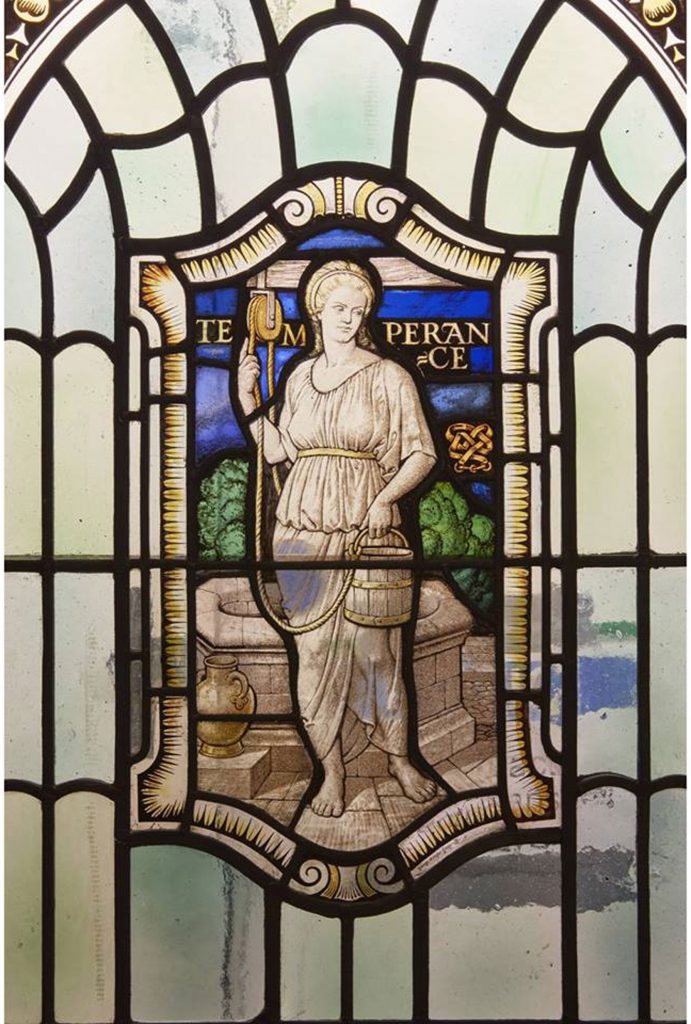
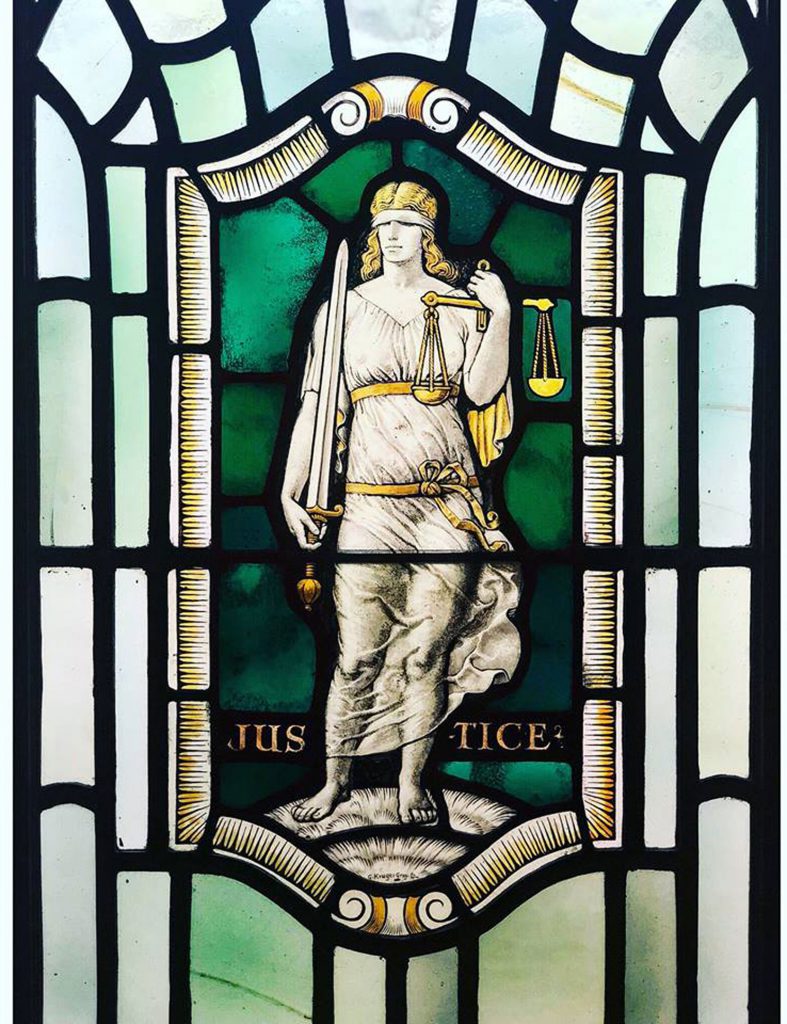
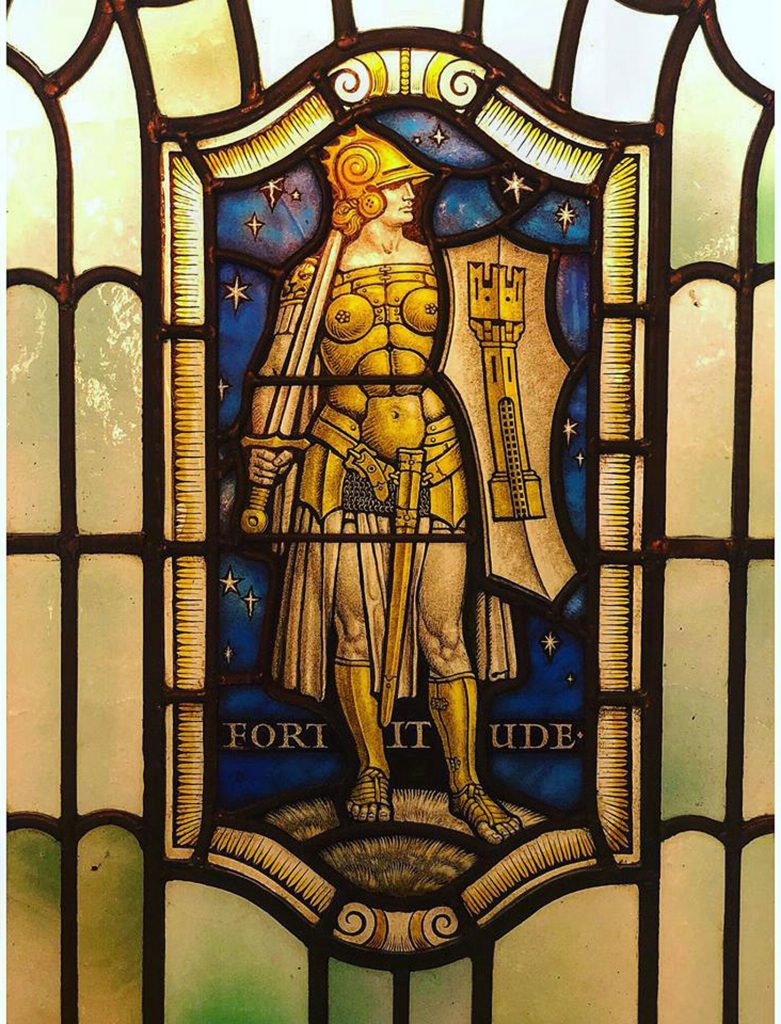
Here is a brief overview of the development of the Four Cardinal Virtues in Western philosophy.
Plato’s Republic (Circa 380 BC)
The Four Cardinal Virtues originate specifically in Books 4, 6, and 7 of Plato’s Republic (circa 380 BC)
In Plato’s Republic, the four cardinal virtues are wisdom, temperance, courage and justice. These reflect the nature of the soul, which has three parts:
1. Reason: Our reason thinks; when it does this well, it has wisdom.
2. Appetite: Our appetite desires; when it does this well, it has temperance (self-control, soberness). Think of this as “passions”.
3. Spirit: Our “high spirit” shows emotions (fear, anger, respect, etc.); when it does this well, it has courage.
For Plato, Justice consists of the proper interplay of the three parts of the soul. In the just person, reason controls the “high spirit” — and both control the appetite (passions).
Plato then applies this to society as a whole:
Society mirrors the individual soul. And the virtues of society mirror the virtues of the individual soul.
Plato divides society into three groups.
1. The aristocrats are the educated; they should be wise [Prudence].
2. The workers (merchants, commoners) do the work; they should be temperate (have self-control) [Temperance].
3. The soldiers (guardians) protect the city; they should be courageous (brave) [Fortitude].
For Plato, Justice in society is the proper conformity of the three groups to their social roles. Each group has its own place, according to its natural abilities. The aristocrats are to rule wisely, and the other groups are to obey and to do their own tasks. This will promote the happiness of the city and of its members.
The Four Cardinal Virtues were adopted by the Roman and Greek Stoics, circa 200 BC.
Stoic Philosophers on the Four Cardinal Virtues
Stoic philosophers (including Marcus Aurelius, Cicero, Seneca, Arius Didymus) recognized Prudence, Temperance, Fortitude and Justice as the four primary or Cardinal Virtues.
As an example, here is a short extract from Cicero (106 BC – 46 BC), On Duties
“….there is not a shadow of a doubt that man has the power to be the greatest agent of both benefit and harm towards his fellow men. Consequently it must be regarded as a vitally important quality to be able to win over human hearts and attach them to one’s own cause…..But to gain the goodwill of our fellow human beings, to convert them to a state of ready activeness to further our own interests, is a task worthy of the wisdom and excellence of a superman…. [note: for Cicero this means behaving with Justice]
This brings me back to moral goodness. It may be held to fall into three subdivisions.
The first is the ability to distinguish the truth from falsity, and to understand the relationships between one phenomenon and another and the causes and consequences of each [note: Prudence]
The second category is the ability to restrain the passions and to make the appetites amenable to reason [note: Temperance]
Third…is the capacity to behave considerately and understandingly in our associations with other people. [note: for Cicero this was Fortitude]…..”
Note the similarity to Plato’s three parts of the soul, tempered by Justice, or the interplay of the three parts of the soul.
For the Stoics, all other virtues were grouped – or hinged – around, or under, the Four Cardinal Virtues. The word “Cardinal” comes from the Latin “cardo” meaning “hinge” and “cardinalis” or “acting as a hinge”, hence the name Cardinal Virtues.
Book of Wisdom – circa 200 BC
The Four Cardinal Virtues appear in Jewish writings about 200 BC in the Book of Wisdom. Although the Book of Wisdom is attributed to King Solomon, the earliest known written references to it date from about 200 BC in Alexandria.
Bible – Book of Wisdom – circa 200 BC
“For [Wisdom] teaches temperance and prudence, justice and fortitude, and nothing in life is more useful for men than these” (Book of Wisdom 8:7).
[Note: although the Book of Wisdom is presented as having been written by King Solomon, it is thought to have been written in Alexandria, by a Jewish author, circa 200 BC. At that time, Alexandria was ruled by the Ptolemy dynasty, which was of Greek (Hellenistic) origin.]
The Four Cardinal Virtues come into Christian thought with St. Paul in 1 Corinthians 13.
St. Augustine wrote of the Cardinal Virtues in De moribus ecclesiastica. 1,25,46:PL 32,1330-1331. [388 AD]
“To live well is nothing other than to love God with all one’s heart, with all one’s soul and with all one’s efforts; from this it comes about that love is kept whole and uncorrupted (through temperance). No misfortune can disturb it (and this is fortitude). It obeys only [God] (and this is justice), and is careful in discerning things, so as not to be surprised by deceit or trickery (and this is prudence)….”
St. Thomas Aquinas (1225-1274) ranked the four Cardinal Virtues in what he considered their priority or precedence.
St. Thomas Aquinas ranked prudence as the first cardinal virtue because it is concerned with the intellect. Aristotle defined prudence as recta ratio agibilium, “right reason applied to practice.” It is the virtue that allows us to judge correctly what is right and what is wrong in any given situation. When we mistake the evil for the good, we are not exercising prudence—in fact, we are showing our lack of it.
In St. Thomas Aquinas‘ view, it is very easy to fall into error, so Prudence requires us to seek the counsel of others, particularly those we know to be sound judges of morality. Disregarding the advice or warnings of others whose judgment does not coincide with ours is a sign of imprudence.
Justice, according to Saint Thomas Aquinas, is the second cardinal virtue, because it is concerned with the will. As Fr. John A. Hardon notes in his Modern Catholic Dictionary, it is “the constant and permanent determination to give everyone his or her rightful due.” We say that “justice is blind,” because it should not matter what we think of a particular person. If we owe him a debt, we must repay exactly what we owe.
Justice, wrote Saint Thomas Aquinas, is also connected to the idea of rights. While the term “justice” in a negative sense (“He got what he deserved”), justice in its proper sense is positive. Injustice occurs when we as individuals or by law deprive someone of that which he is owed. In St. Thomas’ view, legal rights can never outweigh natural rights, a concept which is enshrined in, among other places, the US Declaration of Independence.
The third cardinal virtue, according to St. Thomas Aquinas, is Fortitude. While this virtue is commonly called courage, it is different from what much of what we think of as courage today. Fortitude allows us to overcome fear and to remain steady in our will in the face of obstacles, but it is always reasoned and reasonable; the person exercising fortitude does not seek danger for danger’s sake. Prudence and justice are the virtues through which we decide what needs to be done; fortitude gives us the strength to do it.
Temperance, Saint Thomas declared, is the fourth and final cardinal virtue. While fortitude is concerned with the restraint of fear so that we can act, temperance is the restraint of our desires or passions. Food, drink, and sex are all necessary for our survival, individually and as a species; yet a disordered desire for any of these goods can have disastrous consequences, physical and moral.
Temperance is the virtue that attempts to keep us from excess, and, as such, requires the balancing of legitimate goods against our inordinate desire for them. Our legitimate use of such goods may be different at different times; temperance is the “golden mean” that helps us determine how far we can act on our desires.
Also see https://www.thoughtco.com/the-cardinal-virtues-542142
Some Articles For Additional Research
Some Videos for Additional Research
Here are some videos for research and information purposes. Note that, although some of them are from particular religious viewpoints, we have included these videos here for research purposes only and their inclusion here should not be viewed in any way as a promotion of any particular religious or theological viewpoint:
Here is a video on Plato’s view of the Four Cardinal Virtues in Book 4 of The Republic (note: audio isn’t great):
Here is a video on the Stoic philosophers’ view of the Four Cardinal Virtues
Cicero, On Duties and General Issues Concerning Duty
Here is a short video on the Four Cardinal Virtues from a Roman Catholic perspective:
Here is a short video on the Three Theological Virtues from a Roman Catholic perspective:
Here is a video on the 4 Cardinal Virtues from an Islamic perspective:
Faith, Hope and Charity / Faith, Hope and Love a.k.a. The Theological Virtues
Are Connected to the Four Cardinal Virtues
Here are two videos on the Theological Virtues from a Roman Catholic perspective:
Here is a video on The Ladder of Ascent, based on Jacob’s Ladder:
Here is a depiction of the Four Cardinal Virtues taken from a 10th century Masonic chart:
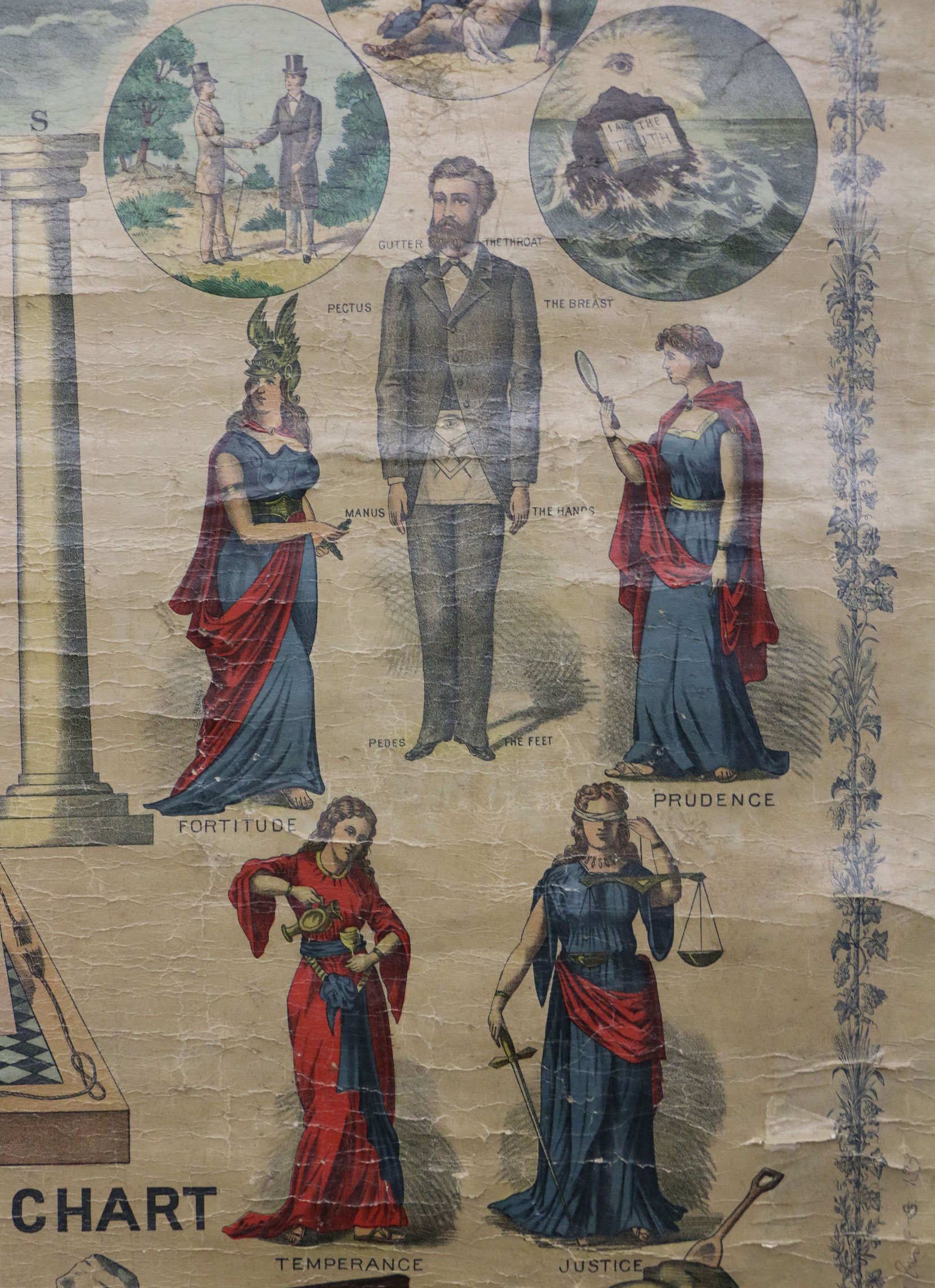
Would you like to leave a comment or question about anything on this post?